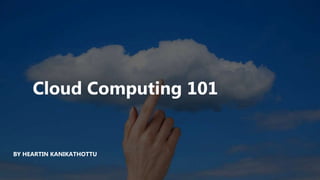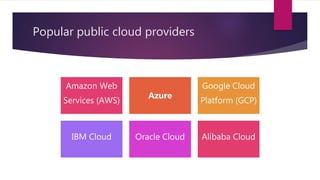Cloud1 Computing 01
- 1. Cloud Computing 101 BY HEARTIN KANIKATHOTTU
- 3. History of computing ïĩ Bare metal ïĩ A single host machine ïĩ Server Virtualization ïĩ One host machine with multiple virtual machines managed by hypervisors. ïĩ Containers ïĩ Multiple light weight containers in one host machine or one virtual machine.
- 4. Introduction to Containers ïĩA container packages all software components into a single deployable unit and is often compared to a shipping container. ïĩValue best understood with the âWorks on my computerâ problem experienced by many software developers ïĩContainers are lightweight alternatives to virtual machines. ïĩDocker is one of the most popular container product.
- 5. Which company created docker? Answer in the LIVE poll
- 6. Container Orchestration â Managing containers Kubernetes (K8s) is one of the most popular container orchestration tools. Kubernetes originally started as an internal project at Google and later was made open source. Kubernetes can be used for the management, scaling and deployments of containers efficiently. Kubernetes as a service is available on most public clouds: EKS on AWS, GKE on Google Cloud and AKS on Azure. Kubernetes is usually referred to as K8s.
- 7. Who manages the K8s project now? Answer in the LIVE poll
- 8. Road to the cloud ïĩ Data centers ïĩ Abstract the actual physical hosting environment ïĩ Hardware is the primary unit of scale
- 9. What is cloud computing? ïĩ On-demand and automated provisioning of computer resources: ïĩ computing, networking and storage. ïĩ Pay per use. ïĩ Abstractions at different levels: ïĩ Infrastructure ïĩ Platform ïĩ Software ïĩ Containers ïĩ Functions ïĩ Backend
- 10. Advantages of cloud computing Replaces up-front capital infrastructure expenses (CapEx) with low variable operational costs (OpEx) that scale with your business. 1.Provides flexibility between capital expenditure (CapEx) and operational expenditure (OpEx). Businesses no longer need to plan for and procure IT infrastructure weeks or months in advance. Benefit from the experience and purchasing power of a cloud provider such as AWS, Azure, GCP etc.
- 11. Advantages of cloud computing (Cont.) Do not have to worry about hardware maintenance. 1.Do not have to worry about securing physical servers Flexibility to save long term using reserved VMs (CapEx). Can close on-premise data centers once we migrate to public cloud.
- 12. Question ïĩ Which expenditure model should you use for migrating all the virtual machines to an Azure pay-as-you-go subscription? ïĩ operational ïĩ elastic ïĩ capital ïĩ scalable
- 13. Features of cloud computing ïĩ High Availability - Ensuring an agreed level of operational performance, usually uptime. ïĩ Scalability - Capability to adapt and perform well under an increased or expanding workload or scope. Also referred to as Dynamic scalability. ïĩ Elasticity â Allocation of required resources to meet current needs. Scalability is generally achieved through elasticity ïĩ Fault Tolerance - Ensuring that servers or services remain available even if some fail. ïĩ Disaster Recovery - Maintain or quickly resume mission-critical functions after a failure. ïĩ Low latency â Ability to access services faster through internet. May use CDNs.
- 14. Achieving BCDR through Azure Site Recovery ïĩ Azure site recovery help us achieve business continuity and disaster recovery (BCDR) strategy ïĩ It helps us keep our data safe, and our apps and workloads online, during planned and unplanned outages. ïĩ Azure Recovery Services contributes to your BCDR strategy: ïĩ Site Recovery service replicates workloads running on physical and VMs from a primary site to a secondary location. When an outage occurs at primary site, we fail over to secondary location. After the primary location is running again, you can fail back to it. ïĩ Backup service: The Azure Backup service keeps your data safe and recoverable.
- 15. Exam Tips ïĩ Capital expenditure (CapEx) is the initial investments such as buying fixed assets. Operational expenditure (OpEx) is the ongoing costs including annual costs. ïĩ With on-premise, these features means more hardware that will be used only when needed, but with cloud these resources are provisioned on-demand. ïĩ In High availability, performance and uptime in response to increasing demand is considered. With Fault tolerance, only uptime in response to a failure is considered. ïĩ In Fault tolerance, service continues after failure. In Disaster recovery, service may be interrupted but recover faster. ïĩ Scale up means replacing servers with more capacity ones (or increasing its capacity). Scale out means adding more servers and processing in parallel.
- 16. Traditional abstractions for cloud â IaaS, PaaS and SaaS âĒ abstract the physical infrastructure layer and expose computing, storage and networking as service. âĒ Unit of scale is the operating system. âĒ Examples of IaaS include Azure Virtual Machine. Infrastructure as a Service (IaaS) âĒ Cloud provider takes care of the virtual machine and operating system and developer is only responsible for the application. âĒ With PaaS, application is the unit of scale. âĒ Examples include Azure SQL Database. Platform as a Service (PaaS) âĒ Software that is available on cloud as a service. âĒ Unit of scale is software. âĒ SaaS services include email, video streaming services, document sharing services etc. Software as a Service (SaaS)
- 17. Traditional cloud abstractions - Responsibilities ïĩ Color code: ïĩ Customer managed ïĩ Cloud-provider managed
- 18. Question ïĩ Recommend a cloud deployment solution to minimize the amount of administrative effort used to manage a web application on cloud. ïĩ SaaS ïĩ PaaS ïĩ IaaS ïĩ Database as a Service (DaaS)
- 19. Question ïĩ A company plans to deploy several custom applications to the cloud where each application has several prerequisite applications and services installed. Which cloud deployment solution is suitable for all the applications. ïĩ SaaS ïĩ PaaS ïĩ IaaS
- 20. Exam Tips ïĩ An IaaS solution provide control of the operating systems that host applications. ïĩ A PaaS solution provides the ability to scale the platform automatically ïĩ In a SaaS solution, end users are responsible for only configuring the SaaS solution.
- 21. Multi-cloud PaaS ïĩ Support multiple cloud providers. ïĩ Examples: Cloud Foundry, Heroku. ïĩ Cloud Foundry ïĩ Multi-cloud application platform as a service governed by the Cloud Foundry Foundation. ïĩ Heroku ïĩ Cloud platform as a service supporting several programming languages. ïĩ It now supports Java, Node.js, Scala, Clojure, Python, PHP, and Go.
- 22. Serverless Computing ïĩ We pay only for the time we execute our code. ïĩ Originally the term serverless was used to refer to Function as a Service (FaaS). ïĩ FaaS allows us to run code (functions) without worrying about managing the server and the runtime environment. ïĩ Currently also be used to refer to Backend as a Service (BaaS) and other fully managed applications, where we can create backends or services without provisioning or configuring any database servers. ïĩ Serverless computing is made possible mostly using containers. ïĩ Examples: AWS Lambda functions, Azure functions.
- 23. Type of clouds â Cloud deployment models Public cloud Private cloud Hybrid cloud
- 24. Question ïĩ An organization that hosts its infrastructure in a __________ can close its data center. ïĩ private cloud ïĩ hybrid cloud ïĩ public cloud
- 25. Question ïĩ Recommend a solution that provides additional resources to your on-premises network with minimizing capital and operational expenditure costs. ïĩ a complete migration to the public cloud ïĩ an additional data center ïĩ a private cloud ïĩ a hybrid cloud
- 26. Tips ïĩ Important characteristics of public cloud include metered pricing and self-service management (automations) ïĩ The public cloud is shared by multiple corporations each using a portion of the resources in the cloud ïĩ A private cloud may not be disconnected from internet, but the access may be limited to people within an organization or whomever they designate
- 27. Popular public cloud providers Amazon Web Services (AWS) Azure Google Cloud Platform (GCP) IBM Cloud Oracle Cloud Alibaba Cloud
- 28. Are cloud-native applications specific to cloud providers? Answer in the LIVE poll
- 29. What is cloud Native? ïĩ A cloud-native application is an application that has been designed and implemented to run on cloud and to embrace horizontal elastic scaling. ïĩ The word ânativeâ in âcloud nativeâ may make us thing that only the applications developed natively within a cloud can be considered cloud native. This is not true. The âcloud nativeâ phrase is used commonly throughout most IT circles today. Other phrases like âcloud friendly,â âcloud ready,â or âcloud optimizedâ could be used for the same, but they are neither as catchy nor as widely recognized as the term âcloud nativeâ.
Editor's Notes
- #4: Type 1 vs. Type 2 hypervisors.
- #7: Kubernetes is usually referred to as K8s because there are 8 letters between the starting k and ending s.
- #17: While IaaS and PaaS are designed for developers, SaaS is designed for end users.Â
- #22: Cloud Foundry: Originally developed by VMware, transferred to Pivotal Software but brought back into VMware at the end of 2019 with VMware's take over of Pivotal.
- #23: Nothing for the idle capacity. About my book.





























